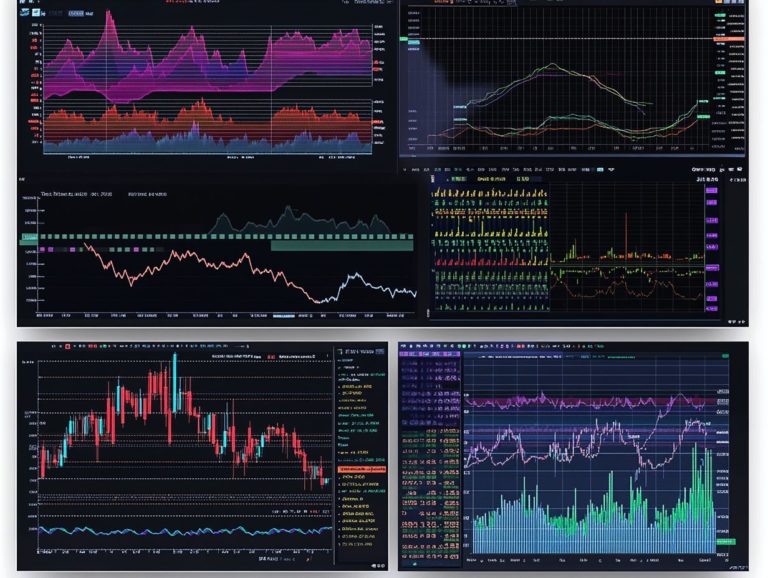Common Mistakes in Technical Analysis
Navigating the world of trading can be both exhilarating and daunting, particularly when it comes to technical analysis. Many traders lean on charts and indicators to guide their decisions, but there are common pitfalls that could lead you to costly errors.
This article delves into 15 prevalent mistakes traders often make, from neglecting fundamental analysis to disregarding risk management. By recognizing these missteps, you’ll be better positioned to refine your trading strategy and boost your chances of success.
Dive in to uncover how to sidestep these traps and elevate your trading game!
Contents
- Key Takeaways:
- 1. Relying Solely on Indicators
- 2. Ignoring Fundamental Analysis
- 3. Not Considering the Market Trend
- 4. Overlooking Risk Management
- 5. Not Having a Trading Plan
- 6. Chasing After High Returns
- 7. Using Technical Analysis in Isolation
- 8. Failing to Adapt to Market Changes
- 9. Not Understanding the Basics of Technical Analysis
- 10. Not Keeping Track of Trades
- 11. Being Overly Confident
- 12. Trading Without Stop Losses
- 13. Not Diversifying Your Portfolio
- 14. Falling for Confirmation Bias
- 15. Not Seeking Professional Guidance
- Frequently Asked Questions
- What are some common mistakes in technical analysis?
- Is it a good idea to rely solely on technical indicators?
- How important is it to consider market trends in technical analysis?
- Why is not properly managing risk a mistake in technical analysis?
- Should I always follow technical analysis blindly?
- How can I avoid making common mistakes in technical analysis?
Key Takeaways:

- Relying solely on indicators can lead to incorrect analysis and decision-making.
- Ignoring fundamental analysis can cause you to miss important market factors that could impact trades.
- Considering market trends is crucial for successful technical analysis and trading strategies.
1. Relying Solely on Indicators
Relying solely on indicators can lead to significant trading mistakes. Often, traders neglect the overall market feeling, price action, and trader psychology.
This oversight can ruin your trading performance in financial markets. When you overlook the nuances of emotional trading, you miss critical insights that could inform your decisions.
Chart analysis, which shows historical price movements, holds invaluable information. This enhances your understanding when paired with various tools like moving averages or trend lines.
Comprehensive market analysis equips you with a deeper perspective on external factors, such as economic news and geopolitical events, that drive market volatility. By integrating these elements into your trading strategies, you can cultivate a more balanced approach.
This holistic method not only fosters consistency in your results but also gives you the power to adapt effectively to changing market conditions.
2. Ignoring Fundamental Analysis
Ignoring fundamental analysis can greatly hinder your ability to make informed trading decisions. This neglects the market trends and price movements essential for crafting a robust trading strategy.
By weaving fundamental analysis into your trading approach, you gain a clearer understanding of the broader economic factors influencing various asset classes. For example, when a central bank announces changes to interest rates, you might witness immediate shifts in stock prices and impacts on cryptocurrency valuations.
As market news unfolds, understanding earnings reports can shed light on potential stock growth. Additionally, regulatory updates can significantly sway investor sentiment in the crypto realm.
This complementary analysis gives you the power to react to current market conditions and anticipate future trends. Ultimately, this refines your decision-making process.
3. Not Considering the Market Trend
Failing to consider market trends can lead you down a path of misguided trading decisions. Overlooking these essential cycles risks crafting strategies that simply don t align with the current market environment.
Understanding market trends is vital for any trader aiming to elevate their performance. These trends often dictate the momentum of price movements, and recognizing them can offer invaluable insights into future market behavior.
You can harness the power of chart analysis to detect emerging patterns and trends. Employing various technical indicators helps validate your findings. By examining moving averages, relative strength indices, and other tools, you can develop a solid entry strategy that aligns with market direction.
This approach enhances your chances of success while minimizing your risk exposure. Ignoring these crucial elements can lead to impulsive decisions that jeopardize your long-term profitability.
Review your trading strategies based on the discussed mistakes to improve your performance.
4. Overlooking Risk Management
Overlooking risk management ranks among the most critical trading mistakes, capable of costing you your hard-earned capital. Without a robust strategy, uncontrolled risks and insufficient stop-loss (a predetermined price point to limit losses) measures can lead to significant losses.
Establishing a solid framework for managing risk is essential for anyone aiming for success in the financial markets. You must recognize that, without effective measures in place, even the most promising trading strategies can crumble in the face of unexpected market fluctuations.
Prioritizing stop losses is crucial; think of them as your safety nets designed to minimize potential losses and secure profits during turbulent times. By maintaining a disciplined approach, you can seize valuable opportunities while consistently safeguarding your investments.
By balancing these principles, you can navigate the complexities of the financial landscape with enhanced confidence and security.
5. Not Having a Trading Plan

Not having a well-defined trading plan can lead you down a path of inconsistent trading actions, stripping away the structure necessary to adhere to trading rules and achieve optimal performance.
A robust trading plan includes essential components like clear entry and exit strategies that give you the power to make informed decisions on when to jump in or gracefully bow out of a position. Effective risk management techniques are crucial; they help mitigate potential losses, ensuring you can weather unfavorable market conditions without taking a significant financial hit.
A trading journal can significantly boost your growth. It helps you analyze past trades and spot patterns in your decisions. By sticking to a well-structured plan, you cultivate a disciplined mindset, which enhances your overall performance and boosts the chances of long-term success.
6. Chasing After High Returns
Chasing after high returns is a common trading mistake that can easily lead to FOMO (Fear of Missing Out), causing you to make impulsive emotional decisions that threaten your financial stability.
This psychological trap often kicks in when you see others raking in significant profits, compelling you to act hastily in hopes of catching those same gains. The urgency that arises from these comparisons may cloud your judgment, leading to unwise investments.
To combat FOMO, you can adopt strategic measures, like establishing clear trading plans that prioritize long-term goals over fleeting opportunities.
Regularly assessing your trading performance will help you cultivate discipline, allowing you to concentrate on consistent, steady results rather than falling for the siren call of immediate financial rewards.
7. Using Technical Analysis in Isolation
Relying solely on technical analysis can cause you to miss vital components like market sentiment and trader psychology, both of which are crucial for accurately interpreting trading signals.
When you blend technical indicators with fundamental insights and the current market mood, you cultivate a more comprehensive understanding of market dynamics. This multi-dimensional approach gives you the power to effectively spot key trends and reversals.
For instance, grasping how news events influence market sentiment can dramatically shift your interpretation of a technical breakout. By considering these factors, you can refine your setups and boost the chances of making well-informed decisions, ultimately enhancing both your risk management strategies and your overall performance in the financial markets.
8. Failing to Adapt to Market Changes
Failing to adapt to market changes can seriously hinder your trading success. It prevents you from adjusting your strategies to align with the ever-evolving market conditions and trends.
Being flexible is key; it allows you to reduce risks and seize emerging opportunities. For example, when unexpected news hits or economic indicators shift, a trader who diligently monitors market analysis can quickly reassess your positions.
By utilizing tools like technical analysis, moving averages, and trend lines, you can refine your strategies based on real-time data, shifting your focus from long positions to more conservative tactics or the other way around.
This kind of responsiveness not only helps you realize profits but also serves as a safeguard against potential losses. It highlights the critical need for agility in today s unpredictable trading landscape.
9. Not Understanding the Basics of Technical Analysis
Failing to grasp the basics of technical analysis can lead you down a path of significant trading errors. This undermines your ability to interpret candlestick patterns, which is a way to visualize price movements over time, and utilize trading indicators effectively.
Understanding these foundational concepts is crucial. They serve as the bedrock for crafting a strong trading plan. Technical analysis zeroes in on price movements and trading volumes, giving you the power to identify market trends and potential reversals with clarity.
Common indicators like moving averages, the Relative Strength Index (RSI), which shows whether a stock is overbought or oversold, and MACD offer invaluable insights into the dynamics of the market. By applying these tools, you can make more informed decisions, thereby enhancing your overall trading setups.
This knowledge fosters greater confidence and plays a vital role in minimizing risks while maximizing your potential gains.
10. Not Keeping Track of Trades

Not keeping track of your trades through a trading journal is a significant oversight. It may impede your ability to evaluate performance and enhance your trading skills over time.
Without a systematic method for recording your trades, you will struggle to identify patterns, recognize emotional triggers, and make well-informed decisions for future trades. A trading journal serves as a reflective tool, giving you the power to analyze not only your successful trades but also the missteps along the way.
To truly optimize your improvement, it’s essential to document key elements such as:
- Document entry and exit points
- Document position size
- Document market conditions
- Document personal feelings at the time of trading
By regularly reviewing this journal, you can uncover valuable insights into trends and pitfalls. This paves the way for continuous learning and strategic adjustments.
11. Being Overly Confident
Being overly confident can lead you to underestimate risks and make reckless decisions. This ultimately results in significant losses and reinforces negative trading behavior.
This often comes from past successes, creating an inflated self-perception that blinds you to potential pitfalls. When trading, it s essential for you to cultivate a mindset that continuously evaluates and reassesses your strategies. Embracing humility allows you to approach each decision with a level of caution that promotes longevity in the market.
Utilizing techniques such as setting strict stop-loss orders, seeking mentorship from seasoned traders, and regularly reviewing past trades can effectively ground your perspective. This helps you maintain a balanced approach to your trading decisions.
12. Trading Without Stop Losses
Trading without stop losses is one of the most perilous mistakes you can make. It puts your trading capital at risk and can lead to huge losses.
In a volatile market, where prices can fluctuate dramatically in an instant, employing effective methods to limit potential losses is essential for protecting your investments. These methods help you manage risk and enhance your decision-making abilities under pressure.
You should consider different types of stop losses, including:
- Standard stop-loss orders
- Trailing stops
- Guaranteed stop-losses
Each type serves a distinct purpose. For example, trailing stops enable you to lock in profits while still leaving room for growth, navigating the market’s inherent volatility. By integrating these protective measures, you can reduce the impact of price changes, fostering a more resilient approach to your trading endeavors.
13. Not Diversifying Your Portfolio
Neglecting to diversify your portfolio is a critical trading mistake that can heighten your risk and limit your chances for consistent returns across various asset classes.
In the unpredictable realm of financial markets, sticking to a single asset or sector can leave you exposed to significant losses. A well-crafted diversification strategy gives you the power to manage risk more effectively.
By incorporating a blend of asset classes such as stocks, bonds, commodities, and real estate you gain exposure to diverse market trends and boost the potential for overall portfolio growth. Consider allocating portions of your funds across different industries, geographical regions, or even varying trading styles like day trading versus long-term investing.
This approach allows you to capture a broader range of market performance while fortifying yourself against unexpected downturns.
14. Falling for Confirmation Bias
Falling for confirmation bias can distort your perception of market analysis. This leads you to make misguided decisions that only reinforce your existing beliefs instead of allowing you to objectively assess market conditions.
This psychological trap often causes you to cling to favored strategies while ignoring evidence that suggests adaptation or change may be necessary. By focusing solely on data that aligns with your preconceived notions, you risk overlooking emerging trends or warnings, ultimately jeopardizing your potential profits.
To mitigate this bias, actively seek out opposing viewpoints and analyses. Doing so fosters a more comprehensive understanding of market movements. Engaging with a diverse set of informational sources can help you cultivate a balanced perspective, allowing for well-considered choices that are less swayed by initial biases.
15. Not Seeking Professional Guidance

Not seeking professional guidance can be a significant trading mistake, limiting your exposure to invaluable insights and strategies that could elevate your trading experience and performance.
You might find yourself missing out on a wealth of knowledge that seasoned professionals can offer, including practical techniques for managing risks, recognizing market trends, and making informed decisions. Through mentorship, you can thrive in a supportive environment that enables you to sharpen your skills.
Accessing advanced trading platforms is crucial; these tools can help you trade better and understand the markets more deeply. Take advantage of professional guidance for lasting success!
Frequently Asked Questions
Here are some common mistakes traders make in technical analysis.
What are some common mistakes in technical analysis?
Some common mistakes in technical analysis include relying solely on indicators, not considering market trends, and failing to manage risk properly. To enhance your trading strategies, it’s also important to be aware of common psychological mistakes traders make.
Is it a good idea to rely solely on technical indicators?
No, relying only on technical indicators can be a mistake. They often miss market trends and may give misleading signals.
How important is it to consider market trends in technical analysis?
Considering market trends is key. They can seriously affect the accuracy of your signals.
Why is not properly managing risk a mistake in technical analysis?
Neglecting risk management can lead to big losses, even if your analysis is spot on. Always have a risk management plan!
Should I always follow technical analysis blindly?
No, don t just follow technical analysis without question. It’s also important to include fundamental analysis and market news in your trading decisions!
How can I avoid making common mistakes in technical analysis?
To dodge common pitfalls, understand the market well. Use multiple indicators and make sure you have a solid risk management strategy!






